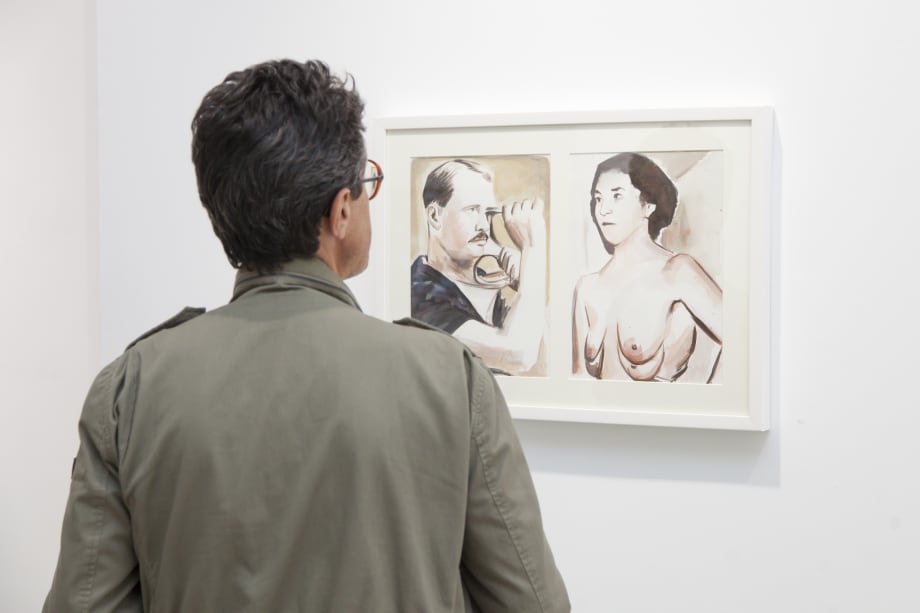Invisibles brings together the works of various national and international artists which present what, according to Emmanuel Levinas, is not given to us, or what we have no idea about, yet with which, nevertheless, we establish relationships. Since it is not possible to adapt the idea to the thing, these relationships are different from those we establish through sight.
In Invisibles we can see something that is difficult, unbearable or inappropriate to articulate by means of the gaze and the word, which is activated by contexts or repositories of popular culture, folklore, daily life, art history, entertainment and trips abroad. The participating artists are Ofir Dor (Israel), Tamrat Gezahegne (Ethiopia), Elad Larom (Israel), Agnès Pe (Lleida), Noemi Sjöberg (Sweden), Mulugeta Tafesse (Ethiopia), Nacho Tusquets (Barcelona) and Juan José Valencia (Tenerife).
Ofir Dor (1972), an Israeli artist living in Berlin, works with subliminal imaginaries through repositories of art history, symbolism or esotericism. The inadequacy of his work is typical of a dark underworld of esoteric cliques and subcultures. In Cannibals Playing in the Park, a violent practice can be seen in a playful way in an urban space that takes wild nature as its model; in Masked Woman there is a glimpse of a fleeting face; and in Studio for Painters' Heads, the painters' faces are reparative gestures, or unclothed faces without definition, that do not totally manage to adapt the idea to what is represented.
The interest of Tamrat Gezahegne (1977), who works in Addis Ababa, is directed towards indigenous knowledge and his holistic way of proceeding, different from the dualistic view. He investigates proverbs, traditional medicine, customary justice systems, dress and spiritual beliefs. Distancing himself from individualistic science, Gezahegne embraces the communitarian character of African indigenous knowledge. Influenced by people living in southern Ethiopia around the Omo Valley who use body paint, jewellery and natural fibres for a variety of purposes, the works in Invisibles are the result of these meditations.
Elad Larom (1976), an Italian and Israeli artist living in Tel Aviv, works mainly with painting, apart from video, animation and photography. In his works, Larom reveals a world of unique characters, scenes and places of popular culture, folklore and everyday life. The views he depicts often belong to magical, and sometimes even spiritual, situations. His paintings, on canvas or on paper, recall cinematic stories, ephemeral moments with "hidden" stills that happen before and after. They are faces not totally unveiled, not totally formed: in some cases masks, plastic surgery, and transitional situations, guided and directed by a medium.
In the video Delta RCA by the artist Agnès Pe (1985), several others, friends and enemies, are present in a game of paintball. The faces of the participants are continually deprived of being seen, but the discourse between them is not. Through the eyes of the participating artist, who records the game with her camera, a relationship is established with the adversary, who, however, is invisible and known to be there. This relationship is guided by the purpose of making him disappear, totally from thought - no longer visible, no longer invisible.
Noemi Sjöberg (1978) lives and works in Stockholm, Barcelona and Paris. Travelling has been the core of her audiovisual works, focusing her attention as a foreigner on the everyday life of the places visited, and the contingency and details that characterize it. Sjöberg reveals a daily life that is alien to the negative aspects we give -often violent and precarious security- to those places due to the information that reaches us in the media. An everyday life made up of playful behaviour that is familiar to us and which is revealed to us.
In A Seated Figure, Mulugeta Tafesse (1960) has painted something that could be human or animal, or both, from the impression or memory of an encounter with an unknown other, interviewed in the poorly lit environment of a night bar. Another, however, recognized in the common human transience. A re-presentation that is the result of distancing oneself from any direct relationship that may be established through the gaze.
In Cruel (2017) and Your Face (2017), Nacho Tusquets (1983), a Catalan artist living in Barcelona, seems to watch over and reveal through gesture and painting what he calls the relationship between music and existence: the irresolution or the indefinite solution; what is happening and what is about to happen. The eye is the only element recognized in a precariously formed face. As if the eye were the main element that could define the face, when it does not allow itself to be captured by the gaze. A look that does not reveal the face but seems to relate empathetically to the eye of the other.
The linoleum interpretations of everyday internet images that Juan José Valencia (1980) selects, produce a déjà vu effect - one has the feeling that they have been seen but is not entirely sure of it. In this way, the images lengthen their existence and do not fade into the frenetic and intense flow that characterises their circulation. The kind of strangeness that occurs is that of the possibly recognized. In these images there are faces that are only glimpsed by the silhouettes and contours typical of the linoleum technique. Faces that, having been captured by the camera, do not possess the details that could characterize them individually. Even so, they are not passive, in their poses they seem to be looking at or photographing the spectator, as if the gaze were reflected, although without revealing a suitable image.


